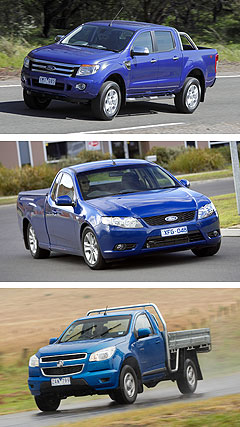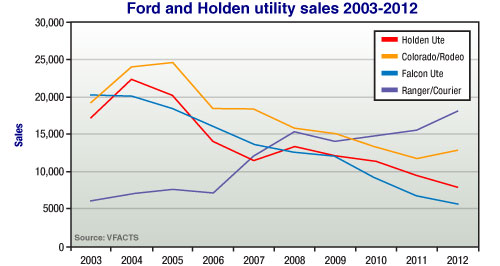News - Market Insight - Market Insight 2013Market Insight: Aussie utes down, but not outWork force: Holden will be hoping the new VF Ute can arrest a 24.5 per cent sales decline this year, and turn around a longer-term move away from its Commodore-based light commercial to bigger imported utilities. Holden looks to VF series for ute sales spark but imported models rule the roost19 May 2013 By TERRY MARTIN GM HOLDEN has made a significant move in slashing prices and improving value across its Australian-built utility range with the forthcoming VF series in an attempt to stem the flow of sales towards imported models. The substantial upgrade brought with the updated series should have a positive impact on the two-door ute, at least in the short term, but questions remain over the longer term future of the passenger-car-based light commercial – not just from Holden, but Ford as well. While Holden has committed to building a new-generation Commodore on a global platform that will be different from the current Australian-developed ‘Zeta’ architecture, the company is still to divulge whether the new underpinnings will be suitable for a utility body style. It will likely have the option to continue building the current ute alongside the all-new sedan later this decade, providing it makes financial sense, which in turn hinges on demand in the marketplace – mainly in Australia but also in potential export destinations such as the US. And demand is the key here. As Ford, too, works on a significantly improved Falcon ute for release next year – and remains quiet on the prospect of a fully redesigned version down the track – demand for both Australian utilities has continued to fall sharply this year in what has been a consistent decline for almost 10 years. Yet this does not represent a plunge in popularity of the utility per se.  From top: Ford Ranger Ute, Ford Falcon Ute and Holden Colorado Ute. From top: Ford Ranger Ute, Ford Falcon Ute and Holden Colorado Ute.On the contrary, sales of imported 4x2 and 4x4 utes have grown in accordance with their increasing popularity with family and recreational buyers – in addition to the traditional trade/business base – and with ongoing improvements in refinement, quality, safety and, not least of all, value, thanks to favourable exchange rates and a free-trade agreement between Australian and Thailand, which is where most of these utes are built. What a traditional imported workhorse ute lacks in terms of engineering sophistication and driving dynamics – typically using a separate chassis construction and live rear axle suspension, for example – it clearly makes up for with its competitive pricing, cab options, extra space, off-road ability and SUV-like seating position, to name a few key factors, compared to the Australian-built ute. Holden and Ford have had mixed fortunes in recent years with the imported Colorado/Rodeo and Ranger/Courier utilities, with the lion brand in particular still a long way from when it was selling around 25,000 a year in the mid-2000s. But with excellent new-generation models now in the market, model variants in place to satisfy demands from a wide range of customers and vehicle supplies flowing freely, both imported pick-ups from the Australian brands are now outselling their smaller locally built counterparts by a big margin. To the end of April, Holden had this year sold 1808 Commodore-based utes (down 24.5%) compared to 4792 new registrations of Colorado, which is up substantially in both 4x2 (+506%) and 4x4 (+127%) guise this year compared to early 2012, when supplies were short due to lingering effects of the late-2011 Thai floods. Ford, meanwhile, has this year seen the 4x2 version of Ranger outsell the Falcon ute, with the (Australian-engineered) Thai model up 26.2 per cent YTD on 1463 units and the Aussie ‘battler’ down 19.7 per cent to 1408. Overall Ranger sales are at 6556 YTD, from a total of almost 58,000 units across about a dozen brands in the market segment so far this year – just five per cent of which can be claimed by the two Australian utes. The downward slide of the two local utes has been quite remarkable, with both companies selling more than 20,000 each some 10 years ago, only to fall to 7925 for Holden last year and 5733 for Ford. For the Broadmeadows-built Falcon tray-back, which reached a peak of 20,200 in 2003, sales have fallen every year since, with the declines deepening in the past three years as the model range dipped below 10,000 in 2010 (-25.3% over the previous year), then below 7000 in 2011 (-25.1%) before tumbling below 6K last year (-15.9%). At its current sales rate, Ford is looking at just 4200 utes leaving showrooms this year. Holden’s Adelaide-built ute has also been spiralling downward since a peak of 22,372 in 2004, faring only slightly better than Ford and similarly deepening in recent years – last year’s sub-8000 result was a 16.5 per cent decline, coming on the back of a 16.8 per cent fall a year earlier when Holden, too, fell below the 10,000 mark. The extent to which the new VF series, and Ford’s forthcoming new ute, has a positive effect on consumer demand and new registrations is really anybody’s guess. Both deserve a good response, but ‘recovery’ is not guaranteed – and not even likely, based on figures shown here. Sales volume, and continued growth, is clearly in more comprehensive model ranges built in cost-effective countries designated as the source of global supply by the world’s leading manufacturers. Thailand, China and Brazil are among these, while Australia – home of the ute for nearly 80 years – looks to be on the outer as the Detroit parents of both Ford and Holden phase out localised products in this more tightly managed modern era.  Read more |
Click to shareMarket Insight articlesResearch Market Insight Motor industry news |

















Facebook Twitter Instagram